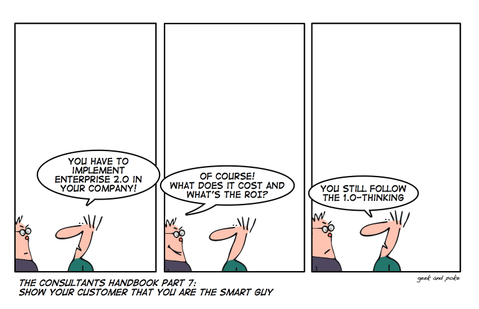 Most Business-IT initiatives require some type of Business Case (cost-justification) to be prepared. The common purposes for these Business Cases include:
Most Business-IT initiatives require some type of Business Case (cost-justification) to be prepared. The common purposes for these Business Cases include:
- Clarify the initiative
- Justify the cost
- Prioritize the initiative against other activities competing for limited resources (e.g., funds, people)
As sensible and worthwhile as these sound, the dirty secret is that most business cases fail to achieve their highest purpose – to help drive value realization from IT investments! Let’s explore this phenomenon.
1. The Business Case as a Clarification Tool
Most (but by no means all!) business cases do a decent to good job at clarifying initiatives:
- What problems are we trying to solve?
- How will this solution solve them?
- What will the solution cost?
- What benefits – tangible and intangible will the solution bring?
- What other solutions were considered?
- Why is this solution recommended?
- What happens if we do nothing?
2. The Business Case as a Cost-Justification Tool
Here is where business cases typically start to fall down:
- Costs are often short-sighted, failing to really anticipate ongoing maintenance, operating and retirement/decommissioning costs.
- Costs are often narrow-minded, failing to really anticipate the cost of change to business processes, competencies and unintended consequences. Most initiatives cost more than you think they will!
- Benefits are often unrealistic, hard to quantify and make all sorts of unstated or unrealistic assumptions.
3. The Business Case as a Prioritization Tool
Given the weaknesses in the business case as a cost-justification tool, it is not surprising that the business case typically does a poor job in helping prioritize initiatives:
- Prioritizing one case against others might be very misleading. Individual projects often become (by initial intent or in retrospect) parts of overarching programs. It is as if my auto service shop tells me I need my front right tire replaced – it will cost me $50 but give me another 5 years of safe driving for that wheel. Oh, by the way, you need your front left tire replaced as well, another $50 for 5 years of safe driving. And so on for the rear tires. Oh, by the way, you will need a wheel alignment—that’s $50. But, we’re running a special: buy 3 tires and get the 4th free, plus we will throw in the wheel alignment for free. Now, do I prioritize 5 separate investments, one for each of the 4 tires plus the option of having all 4 done? Obviously not. The deal would be pitched to me not as 5 investment options, but as one integrated safety ‘program.’ IT business cases, however, are often pitched as separate ‘tire’ investments with the logic that it might be an easier “sell” or because each ‘wheel’ is the responsibility of a different business unit!
- Prioritization at the project level often means juggling and evaluating hundreds of projects. Most business-IT governance bodies are unable to reasonably evaluate so many initiatives.
- Investment prioritization is better handled at the program level—interdependent projects that together achieve an important set of business outcomes. But many Project Management Offices (even if they bear the name Program or Portfolio Management Offices) don’t really work at a program level – they work with laundry lists of individual projects.
- While prioritization at the program level is significantly better than at the project level, even then, program level prioritization often ignores portfolio implications. For example, what I really want from my business-IT investments is some sort of balance between short and long term investments, between high risk, potential high reward and low risk, low reward opportunities. I want some sort of strategic balance—which business units or product lines do I want to be investing in and which am I harvesting? Rarely is the portfolio perspective taken into account—a technique that is just about universal for the personal investment portfolios of all of the business and IT folk involved in the initiatives!
4. The Business Case as a Value Realization Tool
And the most valuable reason for the business case is the one that is almost always absent—value realization!
- What are the tangible sources of value this initiative or program will enable?
- How will these value sources be felt?
- How will we track and measure them and who owns the measurement plan?
- How will we account for them on the books?
- Who is accountable for them?
- What are the consequences of achieving them or failing to achieve them?
- Who are the key beneficiaries and what is their commitment to value realization?
- How will we capture and incorporate lessons learned?
How are you using business cases to drive value realization?














